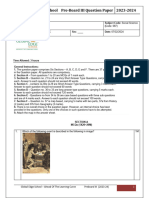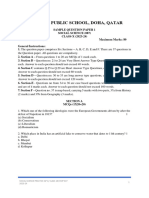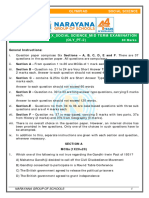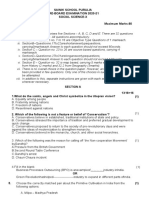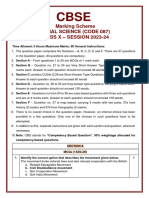Mycbseguide: Cbse Class 10 Social Science Sample Paper - 07 (MCQ Based)
Mycbseguide: Cbse Class 10 Social Science Sample Paper - 07 (MCQ Based)
Uploaded by
KAMAL KAUSHIK X ACopyright:
Available Formats
Mycbseguide: Cbse Class 10 Social Science Sample Paper - 07 (MCQ Based)
Mycbseguide: Cbse Class 10 Social Science Sample Paper - 07 (MCQ Based)
Uploaded by
KAMAL KAUSHIK X AOriginal Title
Copyright
Available Formats
Share this document
Did you find this document useful?
Is this content inappropriate?
Copyright:
Available Formats
Mycbseguide: Cbse Class 10 Social Science Sample Paper - 07 (MCQ Based)
Mycbseguide: Cbse Class 10 Social Science Sample Paper - 07 (MCQ Based)
Uploaded by
KAMAL KAUSHIK X ACopyright:
Available Formats
myCBSEguide
First Term Exam (2021-22)
CBSE Class 10 Social Science
Sample Paper - 07 (MCQ Based)
Maximum Marks: 40 Marks
Time Allowed: 90 Minutes
General Instructions:
i. This question paper is prepared by the team of teachers at myCBSEguide.
ii. It contains 40 questions including MCQ, Case Study, Map and Assertion & Reasoning.
iii. myCBSEguide questions 1-28 are based on Multiple Choice Questions.
iv. myCBSEguide questions 29-33 are based on Assertion & Reasoning Questions.
v. myCBSEguide questions 34 to 37 are based on Case Study Questions.
vi. myCBSEguide questions 38 to 40 are based on Maps.
1. The Estates-General was elected by the body of active citizens and renamed the National Assembly.
New hymns were composed, oaths taken and martyrs commemorated, all in the name of the nation. A
centralised administrative system was put in place and it formulated uniform laws for all citizens
within its territory. The above events took place during which revolution?
a. Industrial revolution
b. American Revolution
c. The Haitian Revolution
d. French revolution
2. What is a coalition government?
a. Alliance of two or more parties
b. Alliance of different social groups
c. Power shared among different organs of government
d. Power shared among different levels of government
3. Which one of the following is a factor a person considers while excepting a job to a far off place?
a. Chances of growth
b. Security
c. Necessity
d. Financial status
To practice more questions & prepare well for exams, download myCBSEguide App. It provides
complete study material for CBSE, NCERT, JEE (main), NEET-UG and NDA exams.
4. The ________ sparked an uprising in Brussels which led to Belgium breaking away from the United
Kingdom of the Netherlands.
a. French Revolution
b. July Revolution
c. October Revolution
d. February Revolution
5. Reena lived with her family in a small village on the outskirts of Diphu in Assam. She enjoys watching
her family members clearing, slashing and burning a patch of land for cultivation. She often helps
Copyright © myCBSEguide.com. Mass distribution in any mode is strictly prohibited. 1 / 9
myCBSEguide
them in irrigating the fields with water running through a bamboo canal from the nearby spring. She
loves the surroundings and wants to stay here as long as she can, but this little girl has no idea about
the declining fertility of the soil and her family’s search for fresh a patch of land in the next season.
Name the type of farming Rinjha’s family is engaged in.
a. Commercial Farming
b. Plantation Farming
c. Intensive Subsistence Farming
d. Jhumming Farming
6. Choose the correct example from the following for Biotic Resource:
a. Human beings
b. Iron ore
c. Book
d. Table
7. ________ ensured that the spirit of federalism, respect for diversity, and desire for living together
became shared ideals in our country.
a. Judiciary
b. Democratic politics
c. Constitutional provisions
d. Federal nature
8. Which of the following activity is of the tertiary sector?
a. Forestry
b. Making sugar
c. Dairy farming
d. Banking
9. Who said, "When France sneezes, the rest of Europe catches cold"?
a. Metternich
b. Giuseppe
c. Lord Byron
d. T S Eliot
10. Agriculture is a ________ activity, which produces most of the food that we consume.
a. service
b. secondary
c. primary
d. tertiary
To practice more questions & prepare well for exams, download myCBSEguide App. It provides
complete study material for CBSE, NCERT, JEE (main), NEET-UG and NDA exams.
11. Panch, a president or sarpanch are ________ elected by all the adult population living in that ward.
a. indirectly
b. hierarchy
c. directly
d. forcefully
12. Which one of the following is not a measure of development in the Human Development Report of the
UNDP?
a. None of these
b. Body mass index
Copyright © myCBSEguide.com. Mass distribution in any mode is strictly prohibited. 2 / 9
myCBSEguide
c. Per capita income in US$
d. Life expectancy at birth
e. Education Levels of the people
13. In 2005, some new laws were made in Russia giving more powers to its:
a. President
b. Prime Minister
c. Legislature
d. Judiciary
14. Which sector is also known as the Industrial sector?
a. Service sector
b. Secondary Sector
c. Primary sector
d. IT(Information technology) sector
15. At least ________ of seats of all positions are reserved for women.
a. half
b. one-third
c. one-fourth
d. two-third
16. What concept of Mahatma Gandhi did Vinobha Bhave spread?
a. Gram swarajya
b. Nagara swarajya
c. Bhoomi swarajya
d. Sacrifice land
17. Which of these sectors are classified on the basis of ownership of enterprises?
a. Primary and secondary sectors
b. Public and Private sectors
c. Organized and unorganized sectors
d. Primary and tertiary sectors
18. Which community has increased the feeling of alienation in Sri Lanka?
a. Indian Tamils
b. Sri Lankan Tamils
c. Sinhalas
d. Christians
19. Which of the following activity is not from the primary sector?
a. Fishing
b. Animal husbandry
c. Making sugar from sugarcane
d. Bee-keeping
20. Ideology is the system of ideas reflecting a particular ________ vision. Choose the correct one.
i. Social
ii. Political
iii. Economical
a. iii and i
b. i , ii and iii
c. i and ii
d. ii and iii
21. The Constitution declared India as a ________ of States.
Copyright © myCBSEguide.com. Mass distribution in any mode is strictly prohibited. 3 / 9
myCBSEguide
a. federation
b. union
c. community
d. departments
22. Which of the following activity is of the secondary sector?
a. Providing loans to the farmer
b. Manufacturing clothes
c. Cultivating cotton
d. Providing a storage facility for the cultivated cotton
23. In which of the following state/states overgrazing is one of the main reason for land degradation?
a. All of these
b. Gujarat and Rajasthan
c. Madhya Pradesh
d. Maharashtra
24. Which language is spoken by 80 percent people of Brussels?
a. Latin
b. German
c. Dutch
d. French
25. India is the second largest producer of sugar after ________ country.
a. France
b. China
c. Brazil
d. Cuba
26. It is an island nation.
a. China
b. Myanmar
c. India
d. Sri Lanka
27. Public facility includes:
a. Tourist places
b. Air
c. Hill stations
d. Public toilet
28. When and who prepared a series of four prints visualising a world of democratic and social Republics?
a. None of these
b. 1815, Duke Metternich
c. 1848, Frederic Sorrieu
d. 1804, Napoleon
For question numbers 29-33, two statements are given- one labeled Assertion (A) and the other labeled
Reason (R). Select the correct answer to these questions from the codes (a), (b), (c) and (d) as given
below:
a. Assertion and reason both are correct statements and reason is correct explanation for assertion.
b. Assertion and reason both are correct statements but reason is not correct explanation for assertion.
c. Assertion is correct statement but reason is wrong statement.
Copyright © myCBSEguide.com. Mass distribution in any mode is strictly prohibited. 4 / 9
myCBSEguide
d. Assertion is wrong statement but reason is correct statement.
29. Assertion: The representatives of the European powers met at Vienna in 1815.
Reason: They met to transfer sovereignty from the monarchy to a body of French citizens and to create a
sense of collective identity amongst the French people.
30. Assertion: The entire tertiary sector has not grown in importance.
Reason: At one end, there are limited numbers of services that employ highly skilled and educated
workers. At the other end, there are a very large number of workers engaged in services such as small
shopkeepers, repair persons, etc.
31. Assertion: Different persons have different notions of development.
Reason: Each person seeks similar things. All persons seek things that are least important for them.
32. Assertion: Resource planning is an easy process in India.
Reason: Resource planning involves planning structure, identification, and inventory of resources across
the regions.
33. Assertion: The French-speaking community in Belgium was rich and powerful.
Reason: Belgian government favored the French-speaking community.
Answer questions 34-37 based on the following case study:
Read the source given below and answer the questions that follow:
The first clear expression of nationalism came with the French Revolution in 1789. France was a full-fledged
territorial state in 1789 under the rule of an absolute monarch. The political and constitutional changes that
came in the wake of the French Revolution led to the transfer of sovereignty from the monarchy to a body of
French citizens. The revolution proclaimed that it was the people who would henceforth constitute the nation
and shape its destiny. From the very beginning, the French revolutionaries introduced various measures and
practices that could create a sense of collective identity amongst the French people. The ideas of La Patrie and
Le Citoyen emphasised the notion of a united community enjoying equal rights under a constitution. A new
French flag, the tricolour, was chosen to replace the former royal standard. The Estates-General was elected by
the body of active citizens and renamed the National Assembly. New hymns were composed, oaths taken and
martyrs commemorated, all in the name of the nation. A centralized administrative system was put in place
and it formulated uniform laws for all citizens within its territory. Internal customs duties and dues were
abolished and a uniform system of weights and measures was adopted. Regional dialects were discouraged and
French became the common language of the nation.
Answer the following MCQs by choosing the most appropriate option:
34. What was the major change that occurred in the political and constitutional scenario due to the French
Revolution in Europe?
a. Transfer of sovereignty from a body of French citizens to the monarchy
b. Establishment of the Congress of Vienna
c. Establishment of Custom Union
d. Transfer of sovereignty from the monarchy to a body of French citizens
35. Mention the proclamation of the French Revolution.
a. The French people would constitute the nation and shape its destiny
b. The monarchy would constitute the nation and shape its destiny
c. The absolutist would constitute the nation and shape its destiny
d. The Napolean would constitute the nation and shape its destiny
36. Which of the following is incorrect with respect to "measures and practices which created a sense of
collective identity"?
a. The Estates-General was elected by the body of active citizens
Copyright © myCBSEguide.com. Mass distribution in any mode is strictly prohibited. 5 / 9
myCBSEguide
b. New hymns were composed and oaths were taken
c. Regional dialects were discouraged
d. A new royal standard flag was chosen to replace the tricolor French flag
37. Which one of the following types of government was functioning in France before the revolution of 1789?
a. Dictatorship
b. Military
c. Body of French Citizen
d. Monarchy
Answer questions 38-40 based on the following Maps
On the map of India, some places are labelled as A, B and C. Answer the questions below based on these labels.
38. In this map, label A represents:
a. Sardar Sarovar Dam
b. Hirakud Dam
c. Nagarjuna Sagar Dam
d. Tungabhadra Dam
39. In this map, label B represents:
a. Uttar Pradesh - Major Sugarcane Producer
b. Maharashtra - Major Sugarcane Producer
c. Karnataka - Major Sugarcane Producer
d. Tamil Nadu - Major Sugarcane Producer
40. In this map, label C represents:
a. Laterite Soil - Nagaland
b. Laterite Soil - Arunachal Pradesh
c. Laterite Soil - Mizoram
d. Laterite Soil – Manipur
Copyright © myCBSEguide.com. Mass distribution in any mode is strictly prohibited. 6 / 9
myCBSEguide
Sample Paper - 07 (MCQ Based)
Class 10 - Social Science
Solution
1. (d) French revolution
Explanation: From the very beginning, the French revolutionaries introduced various measures and
practices that could create a sense of collective identity amongst the French people.
2. (a) Alliance of two or more parties
Explanation: Two or more parties form an alliance to contest elections. If their alliance is elected, they
form a government called a coalition government.
3. (a) Chances of growth
Explanation: Facilities for the family, opportunity to learn, chances of growth, working atmosphere,
and job security are some of the factors a person considers while excepting a job to a far off place.
4. (b) July Revolution
Explanation: The July Revolution sparked an uprising in Brussels which led to Belgium breaking away
from the United Kingdom of the Netherlands.
To practice more questions & prepare well for exams, download myCBSEguide App. It provides
complete study material for CBSE, NCERT, JEE (main), NEET-UG and NDA exams.
5. (d) Jhumming Farming
Explanation: ‘Slash and Burn’ is also called as Jhumming agriculture. A patch of land is cleared by
slashing the vegetation and then the slashed plants are burnt. The ash; thus obtained is mixed with the
soil and crops are grown.
This type of farming produces just enough crops to sustain the family. After a couple of seasons, the
patch is left fallow and a new patch of land is prepared for farming. This allows the earlier patch of
land to replenish its fertility through the natural process.
6. (a) Human beings
Explanation: Biotic Resources: These are obtained from the biosphere and have life such as human
beings, flora, and fauna, fisheries, livestock, etc. Biotic resources are obtained from the biosphere
(living and organic material), such as forests and animals, and the materials that can be obtained from
them. Fossil fuels such as coal and petroleum are also included in this category because they are
formed from decayed organic matter.
7. (b) Democratic politics
Explanation: The real success of federalism in India can be attributed to the nature of democratic
politics in our country. This ensured that the spirit of federalism, respect for diversity, and desire for
living together became shared ideals in our country.
8. (d) Banking
Explanation: The service sector consists of the production of services instead of end products. Banking
is the activity of the tertiary sector which also includes insurance and investment management.
9. (a) Metternich
Explanation: When France sneezes, Metternich once remarked, ‘the rest of Europe catches a cold. The
July Revolution sparked an uprising in Brussels which led to Belgium breaking away from the United
Kingdom of the Netherlands.
10. (c) primary
Explanation: Agriculture is a primary activity, which produces most of the food that we consume.
Besides food grains, it also produces raw material for various industries.
11. (c) directly
Copyright © myCBSEguide.com. Mass distribution in any mode is strictly prohibited. 7 / 9
myCBSEguide
Explanation: This is a council consisting of several ward members, often called panch, and a president
or sarpanch. They are directly elected by all the adult population living in that ward.
12. (b) Body mass index
Explanation: A country scores higher HDI when the lifespan is higher, the education level is higher,
and the GDP per capita is higher. The HDI was developed by Pakistani economist Mahbub ul Haq which
was further used to measure the country's development by the United Nations Development Program
(UNDP). Body mass index (BMI) is a measure of body fat based on height and weight that applies to
adult men and women. It has nothing to do with the measurement of development.
13. (a) President
Explanation: In 2005, some new laws were made in Russia giving more powers to its president, Putin.
14. (b) Secondary Sector
Explanation: The secondary sector is also known as the industrial sector as most of the development of
the sector is related to industries.
15. (b) one-third
Explanation: At least one-third seats of all the positions are reserved for women. But this reservation
is applicable only in the election to the Panchayati Raj Institutions and not in the elections to the State
Assemblies or Lok Sabha.
16. (a) Gram swarajya
Explanation: Mahatma Gandhi declared Vinoba Bhave as his spiritual heir. He also participated in
Satyagraha as one of the foremost satyagrahis. He was one of the votaries of Gandhi’s concept of gram
swarajya.
17. (b) Public and Private sectors
Explanation: on the basis of ownership of enterprises, sectors are classified as Public and Private
sectors. The public sector consists of enterprises that are owned, controlled, and managed by the
government and the private sector consists of enterprises that are owned, controlled, and managed by
individuals or are privately owned. The objective of the public sector is to serve citizens of the country,
whereas the objective of the private sector is to earn a profit.
18. (b) Sri Lankan Tamils
Explanation: All these government measures, coming one after the other, gradually increased the
feeling of alienation among the Sri Lankan Tamils. They felt that none of the major political parties led
by the Buddhist Sinhala leaders was sensitive to their language and culture.
19. (c) Making sugar from sugarcane
Explanation: Extracting sugarcane is an activity of the primary sector however making sugar from
sugarcane is an activity of the secondary sector.
20. (c) i and ii
Explanation: Ideology - System of ideas reflecting a particular social and political vision.
21. (b) union
Explanation: The Constitution declared India as a Union of States as it has established the federal form
of government where the powers are divided into 3 lists- Union, State and Concurrent.
22. (b) Manufacturing clothes
Explanation: The cloth is made in industries, let it be a power loom or handloom but both are a part of
the secondary sector. Therefore manufacturing clothes is the activity of the secondary sector.
23. (a) All of these
Explanation: In states like Gujarat, Rajasthan, Madhya Pradesh, and Maharashtra overgrazing is one
of the main reasons for land degradation. Nearly 30% of India’s land is now undergoing desertification,
primarily as a result of the land degradation accompanying over-cultivation, overgrazing,
deforestation, and the overexploitation of water resources. The root causes of the situation, though, are
Copyright © myCBSEguide.com. Mass distribution in any mode is strictly prohibited. 8 / 9
myCBSEguide
fundamentally linked to growing population levels and the inevitable growing exploitation of the land.
24. (d) French
Explanation: In the capital city Brussels, 80 percent people speak French while 20 percent are Dutch-
speaking.
To practice more questions & prepare well for exams, download myCBSEguide App. It provides
complete study material for CBSE, NCERT, JEE (main), NEET-UG and NDA exams.
25. (c) Brazil
Explanation: India is the second largest producer of sugarcane only after Brazil. It is the main source
of sugar, gur (jaggary), Khansari, and molasses.
26. (d) Sri Lanka
Explanation: Sri Lanka is an island nation, just a few kilometres off the southern coast of Tamil Nadu.
27. (d) Public toilet
Explanation: Public Facilities refer to the facilities that are provided by the government to the people.
These facilities are considerably important to sustain a comfortable life.
28. (c) 1848, Frederic Sorrieu
Explanation: In 1848, Frederic Sorrieu, a French artist, prepared a series of four prints visualising his
dream of a world made up of ‘democratic and social Republics’, as he called them.
29. (b) A is correct but R is wrong
Explanation: The Treaty of Vienna of 1815 was signed with the main aim of undoing most of the
changes that had come about in Europe during the Napoleonic wars. It was signed to re-establish
conservative regions in Europe.
30. (a) Both A and R are true and R is the correct explanation of A.
Explanation: Both A and R are true and R is the correct explanation of A.
31. (c) A is correct but R is wrong
Explanation: Different persons have different notions of development or progress. Each of them seeks
different things. All persons seek things that are most important for them i.e. that which can fulfil their
aspirations or desires.
32. (d) Assertion is a wrong statement but the reason is a correct statement.
Explanation: Resource planning is essential for the sustainable existence of all forms of life. Resource
planning is not an easy but a very complex process as it involves surveying, mapping, quantitative and
qualitative estimation, and measurement of the resources. The reason is correct but the assertion is
false.
33. (c) A is true but R is false
Explanation: There was ethnic tension between french speaking and dutch speaking communities in
Belgium. for resolving the government where all the communities got equal representation.
34. (d) Transfer of sovereignty from the monarchy to a body of French citizens
35. (a) The french people would constitute the nation and shape its destiny
36. (d) A new royal standard flag was chosen to replace the tricolor French flag
37. (d) Monarchy
38. Nagarjuna Sagar Dam
39. Tamil Nadu - Major Sugarcane Producer
40. Laterite Soil - Nagaland
Copyright © myCBSEguide.com. Mass distribution in any mode is strictly prohibited. 9 / 9
You might also like
- (000000000 (Amy - Gallo) Getting Along How To Work With Anyone (Difficult People)Document297 pages(000000000 (Amy - Gallo) Getting Along How To Work With Anyone (Difficult People)Juan FernandezNo ratings yet
- Cover PageDocument228 pagesCover PageKurt ButtersNo ratings yet
- Freud, S. (1920) - Beyond The Pleasure PrincipleDocument2 pagesFreud, S. (1920) - Beyond The Pleasure PrincipleGintare AdasiunaiteNo ratings yet
- Mycbseguide: Cbse Class 10 Social Science Sample Paper - 01 (MCQ Based)Document10 pagesMycbseguide: Cbse Class 10 Social Science Sample Paper - 01 (MCQ Based)NITIKA SHARMANo ratings yet
- Mycbseguide: Cbse Class 10 Social Science Sample Paper - 09 (MCQ Based)Document10 pagesMycbseguide: Cbse Class 10 Social Science Sample Paper - 09 (MCQ Based)KAMAL KAUSHIK X ANo ratings yet
- Mycbseguide: Class 10 - Social Science Sample Paper 01Document16 pagesMycbseguide: Class 10 - Social Science Sample Paper 01Sheela SinghNo ratings yet
- Mycbseguide: Cbse Class 10 Social Science Sample Paper - 05 (MCQ Based)Document11 pagesMycbseguide: Cbse Class 10 Social Science Sample Paper - 05 (MCQ Based)KAMAL KAUSHIK X ANo ratings yet
- Mycbseguide: Cbse Class 10 Social Science Sample Paper - 08 (MCQ Based)Document10 pagesMycbseguide: Cbse Class 10 Social Science Sample Paper - 08 (MCQ Based)Abdul MuqsitNo ratings yet
- Mycbseguide: Cbse Class 10 Social Science Sample Paper - 04 (MCQ Based)Document10 pagesMycbseguide: Cbse Class 10 Social Science Sample Paper - 04 (MCQ Based)KAMAL KAUSHIK X ANo ratings yet
- 10 SST Term1 sp01Document16 pages10 SST Term1 sp01KaranNo ratings yet
- Grade X - SS - Preboard-III Question Paper - 2023-24Document8 pagesGrade X - SS - Preboard-III Question Paper - 2023-24Havisha SapireddyNo ratings yet
- Class X TERM 1 PAPERDocument18 pagesClass X TERM 1 PAPERDev PandeyNo ratings yet
- X SST Question Paper - Common ExaminationDocument9 pagesX SST Question Paper - Common Examinationcartoonexplorers7No ratings yet
- Magnet Brains Test Paper - 2Document24 pagesMagnet Brains Test Paper - 2Mia KhalifaNo ratings yet
- ACFrOgBW0Dk TVe0tpVb9MmWpLH6Gdi5ozoyq6 2KklsnSmo3mN s9YrCIRevLJbpm4NMshUhaitmc61wRD1VYeUGf - nv6bFYffujCx1zBzNUwwt9K4Txo5J19mi2lIDocument12 pagesACFrOgBW0Dk TVe0tpVb9MmWpLH6Gdi5ozoyq6 2KklsnSmo3mN s9YrCIRevLJbpm4NMshUhaitmc61wRD1VYeUGf - nv6bFYffujCx1zBzNUwwt9K4Txo5J19mi2lImr gamerNo ratings yet
- 10 SST PT 2Document2 pages10 SST PT 2Aarav PatelNo ratings yet
- 1.cbse X Social Science Cbse Mid Oly Pt2 Qps 5-06-23Document9 pages1.cbse X Social Science Cbse Mid Oly Pt2 Qps 5-06-23pritusingh63No ratings yet
- Wa0003.Document5 pagesWa0003.xyzNo ratings yet
- Social Science - Sample Q PPRDocument10 pagesSocial Science - Sample Q PPRMarwaNo ratings yet
- Magnet Brains Test Paper - 1Document23 pagesMagnet Brains Test Paper - 1Mia KhalifaNo ratings yet
- Magnet Brains Test Paper - 1Document23 pagesMagnet Brains Test Paper - 1dhairyata vermaNo ratings yet
- 3 QP - CB - X - SSC - Pre Board 2Document9 pages3 QP - CB - X - SSC - Pre Board 2Aditya nairNo ratings yet
- SST Grade 10Document16 pagesSST Grade 10Kanishka KabadiNo ratings yet
- Mabayuan Senior High School: Schools Division of Olongapo CityDocument3 pagesMabayuan Senior High School: Schools Division of Olongapo CityJoseph Mondo�edoNo ratings yet
- Cbjesspu14 231225 181550Document10 pagesCbjesspu14 231225 181550granthagrawal255No ratings yet
- 2 QP - CB - X - SSC - Pre Board 2Document10 pages2 QP - CB - X - SSC - Pre Board 2Aditya nairNo ratings yet
- Social Science Question Paper (Term - 1)Document13 pagesSocial Science Question Paper (Term - 1)Sangket MukherjeeNo ratings yet
- SocialScience SQPDocument14 pagesSocialScience SQPmethesmrtyNo ratings yet
- SocialScience SQPDocument14 pagesSocialScience SQP16739No ratings yet
- Thekaushikgoswami - Preboard Class 10 Question Paper Set 1 Final-6!1!21Document9 pagesThekaushikgoswami - Preboard Class 10 Question Paper Set 1 Final-6!1!21Roshan Kumar SahooNo ratings yet
- Mock Paper of SST Class 10Document8 pagesMock Paper of SST Class 10tanishkararoraNo ratings yet
- Untitled Document 3Document10 pagesUntitled Document 3randip1265No ratings yet
- 20221126sample Question PaperDocument11 pages20221126sample Question PaperManya SinghalNo ratings yet
- Sample Paper SocialDocument10 pagesSample Paper Socialarpitashekhawat2No ratings yet
- Class 10 sample paper SSDocument9 pagesClass 10 sample paper SSurvish.studyNo ratings yet
- First Pre BoardDocument9 pagesFirst Pre Boardshefali08072007No ratings yet
- 5213social Science Sample Paper 1 Class 10thDocument6 pages5213social Science Sample Paper 1 Class 10thvintageashu2008No ratings yet
- Time-90 Minutes MM-40M: Half Yearly Question Paper 2021-22 Term I - Class X Social Science - Code 087Document14 pagesTime-90 Minutes MM-40M: Half Yearly Question Paper 2021-22 Term I - Class X Social Science - Code 087Insha Hasan 10DNo ratings yet
- Jessspsu 02Document11 pagesJessspsu 02FFT GamingNo ratings yet
- SS10Document10 pagesSS10Alex PandiyanNo ratings yet
- Ict 10 Q3 Exam Final Answer KeyDocument2 pagesIct 10 Q3 Exam Final Answer KeyJenelyn RusianaNo ratings yet
- SS Sample Paper 4 UnsolvedDocument10 pagesSS Sample Paper 4 UnsolvedSUJATHA VENKATESANNo ratings yet
- Class 10 R CbseDocument6 pagesClass 10 R CbsesiddharthNo ratings yet
- X Social Science Preboard Term1 QP 041021Document13 pagesX Social Science Preboard Term1 QP 041021Soul ViperNo ratings yet
- Online Quiz IN STSDocument4 pagesOnline Quiz IN STScayabyabkenneth75No ratings yet
- Social Science Class X Sample Paper Test 03 For Board Exam 2023 1Document6 pagesSocial Science Class X Sample Paper Test 03 For Board Exam 2023 1asteria azuraNo ratings yet
- Gen Ed 5Document25 pagesGen Ed 5Leih Anne Quezon AnonuevoNo ratings yet
- ECONOMICS Worksheet DevelopmentDocument7 pagesECONOMICS Worksheet Developmenttanishkagour84No ratings yet
- FC Sem 2Document18 pagesFC Sem 2aratikokane143No ratings yet
- Class 10 100 MCQs (1)Document94 pagesClass 10 100 MCQs (1)sharmalovely38018No ratings yet
- 10 Social Science SP 03Document15 pages10 Social Science SP 03edisonsanasam19No ratings yet
- SST Sample Paper 10 UnsolvedDocument9 pagesSST Sample Paper 10 UnsolvedPrabhu DevaNo ratings yet
- Atharv Sample PaperDocument10 pagesAtharv Sample Papersg8164042No ratings yet
- Cbjesspu 02Document10 pagesCbjesspu 02redlegend606No ratings yet
- Social Science Pre-Board Question Paper 2020-21Document9 pagesSocial Science Pre-Board Question Paper 2020-21free fireNo ratings yet
- 1Rj6kimMRuuPUZVrjIktDocument22 pages1Rj6kimMRuuPUZVrjIktt.charlesmaniNo ratings yet
- Revision Paper Class X-2Document10 pagesRevision Paper Class X-2arvindpaikarayNo ratings yet
- SS PQMS2Document17 pagesSS PQMS2mythplayzmaritalNo ratings yet
- Quarter2 SHS UcspDocument7 pagesQuarter2 SHS Ucspcentydavis.santosNo ratings yet
- Class-10 Social Science (First Pre-Terminal) 2021-22Document9 pagesClass-10 Social Science (First Pre-Terminal) 2021-22M0hit y4shNo ratings yet
- Hjebrngj 8 WXQMWWNKG 7 Pxy 3 J 3 CKPDocument18 pagesHjebrngj 8 WXQMWWNKG 7 Pxy 3 J 3 CKPdiptidev49No ratings yet
- Guinayangan College Foundation Inc.: Readings in Philippine History (Litt 101) - Semi-FinalsDocument4 pagesGuinayangan College Foundation Inc.: Readings in Philippine History (Litt 101) - Semi-FinalsEJERNR JEONNo ratings yet
- Rescher, N. (2003) - Epistemology. An Introduction To The Theory of KnowledgeDocument425 pagesRescher, N. (2003) - Epistemology. An Introduction To The Theory of Knowledgejuan100% (3)
- Gender and Media Tonny K March 3RD 2020Document11 pagesGender and Media Tonny K March 3RD 2020Muhamad Akmal AimanNo ratings yet
- Social Science Heritage of The Middle Ages and The RenaissanceDocument18 pagesSocial Science Heritage of The Middle Ages and The RenaissanceAngelo Mirabel100% (1)
- Effective Business Communication Case Study PDFDocument10 pagesEffective Business Communication Case Study PDFMuhammad ArsalanNo ratings yet
- PR1 L4Document43 pagesPR1 L4Garie PanganibanNo ratings yet
- Lembar Jawaban Utek Mandat Arni Despa P 220104016PDocument8 pagesLembar Jawaban Utek Mandat Arni Despa P 220104016PArni DespaNo ratings yet
- Design For Sustainable Architecture and EnvironmenDocument17 pagesDesign For Sustainable Architecture and EnvironmenAnonymous Qm0zbNkNo ratings yet
- Direction: Choose One Topic/ Statements Listed and Write A One-Page EssayDocument2 pagesDirection: Choose One Topic/ Statements Listed and Write A One-Page EssayShane PaiNo ratings yet
- K. Bhavatarini C. Elakkiya V. Gayathri A. Noor Afrin D. PonkaviDocument25 pagesK. Bhavatarini C. Elakkiya V. Gayathri A. Noor Afrin D. PonkaviTushar GorleNo ratings yet
- Social Science Research in IndiaDocument6 pagesSocial Science Research in IndiaHelly ParikhNo ratings yet
- EthicsDocument317 pagesEthicsqtxxzmy6m4No ratings yet
- The Study On Green Marketing in Retail Industry With Special Reference To Coimbatore CityDocument8 pagesThe Study On Green Marketing in Retail Industry With Special Reference To Coimbatore CityKaviya SkNo ratings yet
- Sociology Health Illness - 2003 - Turner - Corps de Ballet The Case of The Injured Ballet DancerDocument20 pagesSociology Health Illness - 2003 - Turner - Corps de Ballet The Case of The Injured Ballet Dancerarteycultura.veNo ratings yet
- Organizational Behaviour AssignmentDocument14 pagesOrganizational Behaviour AssignmentIbnu SulaimnNo ratings yet
- Chapter IIIDocument7 pagesChapter IIICharles Daryll Contridas100% (2)
- Applied Economics TerminologyDocument5 pagesApplied Economics Terminologyahmie banez100% (1)
- Chapter 3 - PerceptionDocument2 pagesChapter 3 - PerceptionAlleinad GutierrezNo ratings yet
- Backhouse and Medema 2009 On The Definition of EconomicsDocument15 pagesBackhouse and Medema 2009 On The Definition of EconomicsrehakovaerikaNo ratings yet
- Concept of Depersonalized LeadershipDocument5 pagesConcept of Depersonalized LeadershipDaniel O'loughlinNo ratings yet
- Jordan 2018 Masculinizing Care - Gender Ethics of Care and Fathers Rights GroupsDocument22 pagesJordan 2018 Masculinizing Care - Gender Ethics of Care and Fathers Rights GroupskyliecyluiNo ratings yet
- Excerpt 7 - Leading With Wisdom BookDocument42 pagesExcerpt 7 - Leading With Wisdom BookSudha RamNo ratings yet
- 1.4 PNP Professional Code of Conduct and Ethical StandardsDocument42 pages1.4 PNP Professional Code of Conduct and Ethical StandardsSimon TemplarNo ratings yet
- COMM1121 Chapter OneDocument11 pagesCOMM1121 Chapter OneantwanesomersNo ratings yet
- 01.introduction To Research MethodologyDocument14 pages01.introduction To Research MethodologyShivakant UpadhyayaNo ratings yet
- Psychology 20 Chapter 5 True-FalseDocument1 pagePsychology 20 Chapter 5 True-Falseapi-2038142690% (1)
- Measuring The Relationship Between Service Quality and Customer Satisfaction in The Hotel IndustryDocument12 pagesMeasuring The Relationship Between Service Quality and Customer Satisfaction in The Hotel IndustryJosé CuevasNo ratings yet
- Education II Question BankDocument28 pagesEducation II Question BankBidyut PramanikNo ratings yet










